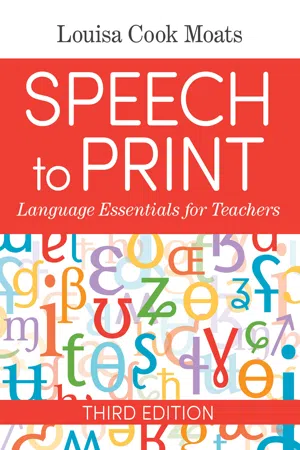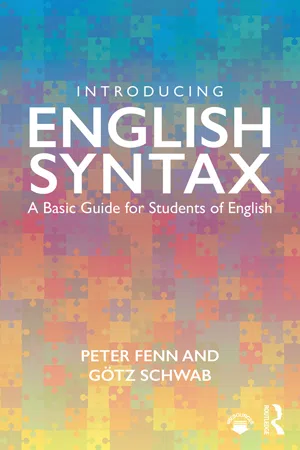Languages & Linguistics
Verb Phrase
A verb phrase is a group of words that includes a main verb and any auxiliary (helping) verbs, as well as any complements, objects, or adverbs that modify the verb. It functions as the predicate in a sentence and expresses an action, occurrence, or state. Verb phrases can be simple, consisting of just a main verb, or complex, incorporating multiple auxiliary verbs and complements.
Written by Perlego with AI-assistance
4 Key excerpts on "Verb Phrase"
- eBook - ePub
Speech to Print
Language Essentials for Teachers
- Louisa Cook Moats(Author)
- 2020(Publication Date)
- Brookes Publishing(Publisher)
These sentences violate phrase structure principles. Rewrite them so that they sound right. 1.Individuals are misdiagnosed commonly and even entirely missed with dyslexia. 2.The student earned from her teacher extra credit for the illustration. 3.Ralph helped generously with the sprained ankle his cousin. 4.Jennifer put for eight hungry guests a holiday meal on the table happily. 5.That there are no more hungry people John imagined.The points made so far about the nature of sentences imply that students’ “ear” for what sounds right in sentence formation can be enhanced with formal instruction that takes these aspects of syntax into account:•A sentence must have a noun phrase and a Verb Phrase. •Phrasal categories include noun, verb, adjective, adverbial, and prepositional phrases, and phrases fulfill slots within an underlying sentence framework. •The head word in a phrase is the main word on which the phrase’s meaning depends. •Noun phrases may have a determiner and optional adjectives, and may fulfill various roles as subjects, objects, or parts of prepositional phrases.•Prepositional phrases generally describe time, place, or the object of a verb; they answer the questions, Where? When? In what way?•Within sentence structure, some phrases are necessary and others are optional (adjuncts). Required or role-defining words in a phrase must be close to the head; optional or adjunctive words cannot get between the head and its required role-definers.•The verb determines what other role-players must be in the sentence—the topic we elaborate next. The Power of the VerbThe Verb Phrase is the one grammatical entity that is required in any English statement, question, or command. Even one-word imperatives have a verb: Halt!Verbs are both powerful and demanding. They determine, at a minimum, what must be in a given sentence. The verb is like a director who dictates what other roles or actors must be in a play. Consider the following examples of sentences that do not sound right: - eBook - ePub
Analysing Sentences
An Introduction to English Syntax
- Noel Burton-Roberts(Author)
- 2021(Publication Date)
- Routledge(Publisher)
4 The basic Verb PhraseDOI: 10.4324/9781003118916-5You now know that the basic sentence consists of a Noun Phrase (functioning as subject) followed by a Verb Phrase (functioning as predicate). This chapter deals with the general structure (the immediate constituents) of the VP half of the basic sentence.Paddle, sunbathed beside a stream, dreads affectionate cats, came to the graduation ceremony and stopped the car are all VPs. As these show, categories introduced in previous chapters can appear in the VP, including NPs. Within the VP, NPs have a range of different functions. It’s these different functions of NP and other phrasal categories that concern us here.A first look at verbs
The one constituent a Verb Phrase (VP) must contain is a head verb (V).There are two kinds of verb in English: lexical and auxiliary . Lexical verbs are the ones that belong to the indefinitely large general vocabulary of the language – e.g. run, eat, apply, explain, recycle, break, prepare, depend …. Auxiliary verbs, by contrast, are a special, restricted set of verbs. The clear ones are: can/could, will/would, shall/should, may/might, must, need – and be, have and do (these three can also be lexical).A full VP must contain alexicalverb and it may containauxiliary verbs . In the following, the lexical verbs are in bold and the auxiliary verbs are in italics.[1a] Diana plays the piano.[1b] Diana played the piano.[2] Anders is explaining his generalisation.[3] Maggie should have recycled those bottles.[4] Francois may have been preparing his lecture.Auxiliaries are dealt with in Chapter 6 . So, this chapter is called ‘The basic Verb Phrase’ because it’s about VPs containing just LEXICAL verbs.Lexical verbs are easily identified by their morphological (i.e. their word-form) possibilities. They take some if not all of the verbal inflections-s, -ing, -ed, -en. For example: plays, playing, played and writes, writing, written - David Hornsby(Author)
- 2014(Publication Date)
- Teach Yourself(Publisher)
Chapter 8 ). For linguists, syntax means the study of the set of rules governing the way that morphemes, words, clauses and phrases are used to form sentences in any given language.Subjects and predicatesHowever, the distinction between ‘word-level’ and ‘sentence-level’ grammar is far from watertight, and there is a considerable grey area between the two. Linguists sometimes refer to morphosyntax when describing phenomena which straddle both levels: grammatical gender, for example, often manifests itself at word level in inflection, but may also affect relations between items within a sentence in the case of the syntactic phenomenon of agreement (or concord).Calling syntax ‘the grammar of sentences’ is all very well, but sentences prove as difficult to define as ‘words’ did in the previous chapter. We are used, in literate societies with a written-language bias, to thinking of a sentence as something that generally begins with a capital letter and ends with a full stop, but this does not get us very far. A traditional definition of a sentence as ‘the expression of a complete thought’ is not helpful either: are elderberry wine, exactly or good! not ‘complete thoughts’? In traditional grammar, sentences were required to have a subject and a predicate, i.e. something we are talking about (the subject) and then something said about it (the predicate):1 Dinosaurs existed.2 Samantha is preparing for her bar examinations.3 Paul gave a tip to the waiter.Identifying the subject in Latin, Russian or Polish would be straightforward, because the nouns would be case-marked, i.e. inflected according to their function in the sentence. This is no longer true of English (though it used to be), but pronouns – with the exception of third-person singular it – do retain case-marked forms, so we can apply a substitution test. Thus in the list above, the subjects are Dinosaurs, Samantha and Paul, because they alone can be replaced by subject (or nominative) forms (they, she and he- eBook - ePub
Introducing English Syntax
A Basic Guide for Students of English
- Peter Fenn, Götz Schwab(Authors)
- 2017(Publication Date)
- Routledge(Publisher)
regularly , then, represent phrases (a Verb Phrase and an adVerb Phrase respectively), i.e. phrases with only one constituent. And by the same token the single-word constituents of (1), (2) and (4) can now be described, more accurately in a syntactic sense, as phrases:p.10 1.3 What word-classes are there, and what are their characteristic features? If you look a word up in a dictionary, you will find that its word-class (part of speech) is given before the meaning. For instance:This underlines a point made above: that word-class is a permanent feature of a particular word, i.e. part of its individual character.We generally distinguish between the following main word-classes: nouns, pronouns, verbs, adverbs, adjectives, prepositions, conjunctions, determiners.We will now point to basic features that identify each word-class, using the three different perspectives of semantics, morphology and syntax. The functional aspect of syntax will not be discussed here, however, as functions are not introduced until the next chapter. Under the ‘syntax’ heading we will confine ourselves for the moment to other kinds of relationship between words.1.3.1 Nouns• Semantics:Nouns denote entities , i.e. living things (person , woman , plant , animal ), objects (table , road , car ), other physical phenomena (weight , distance , electricity , rain , wind ), and abstractions like concepts and ideas (wish , religion , memory , economics , friendship ). Names such as Peter , London , Christianity , Communism are called proper nouns
Index pages curate the most relevant extracts from our library of academic textbooks. They’ve been created using an in-house natural language model (NLM), each adding context and meaning to key research topics.
Explore more topic indexes
Explore more topic indexes
1 of 6
Explore more topic indexes
1 of 4



